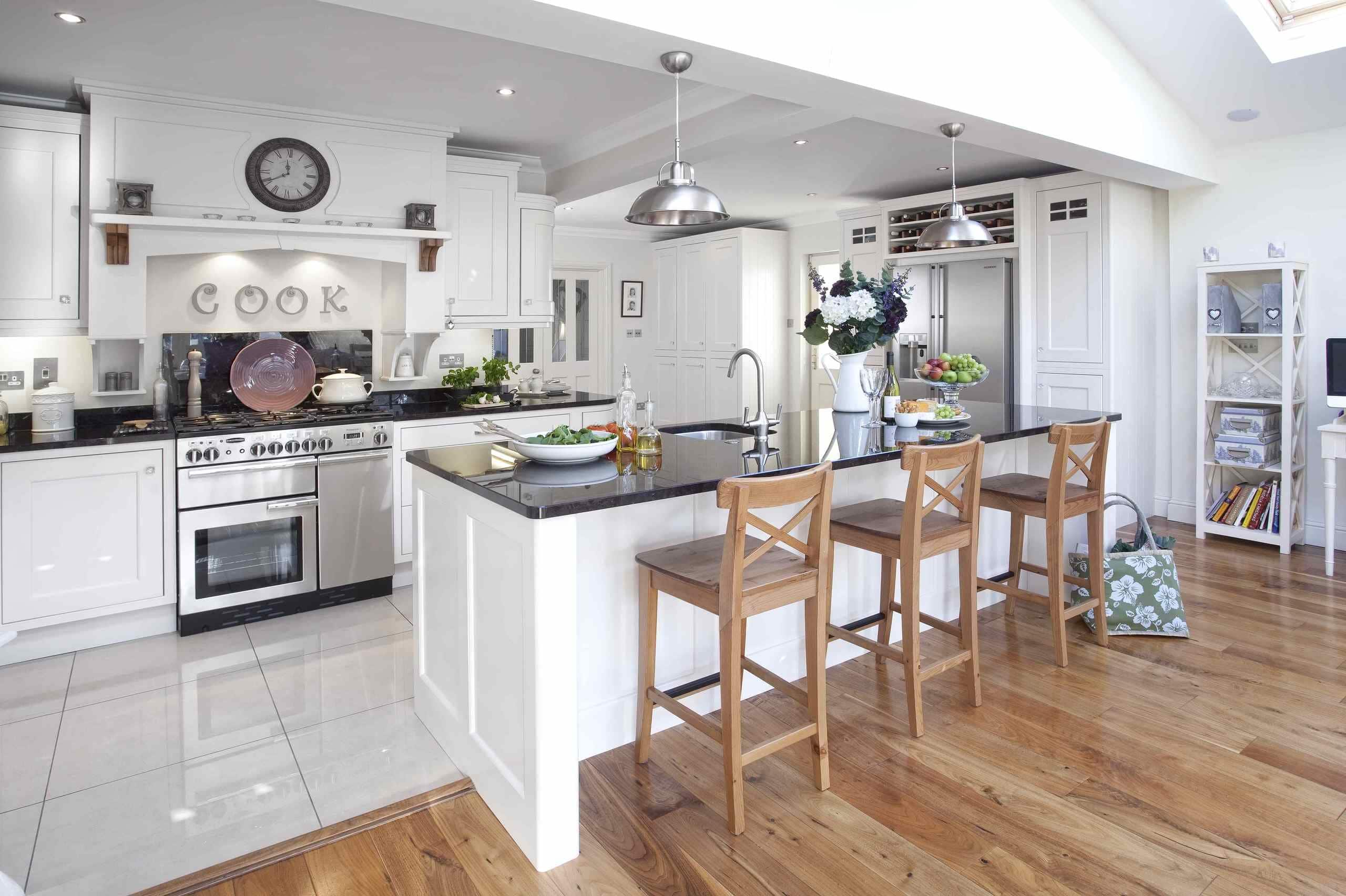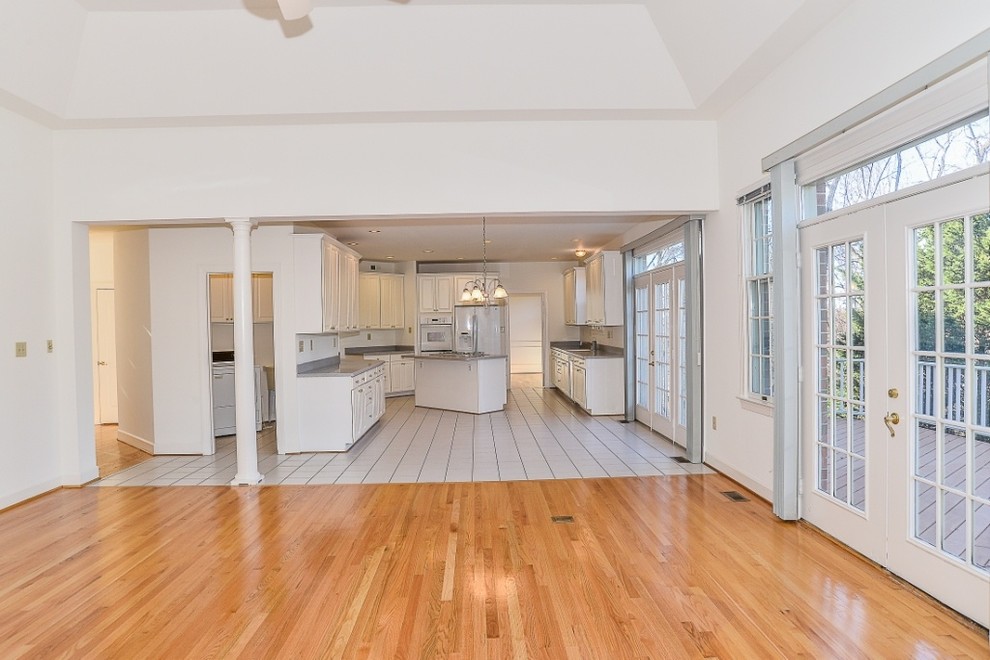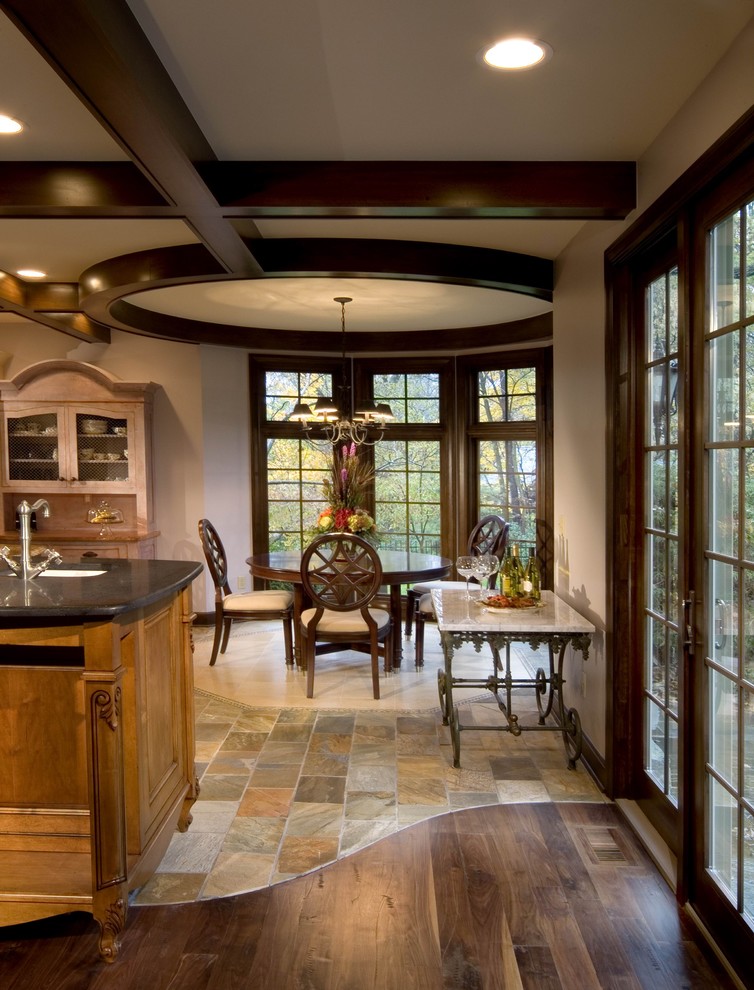Seamless Style: Living Room to Kitchen Floor Transitions
Seamless Style: Living Room to Kitchen Floor Transitions

The living room and kitchen are often the heart of a home, spaces where we gather, cook, eat, and entertain. Creating a cohesive and stylish flow between these two rooms can significantly impact the overall feel and functionality of your home. One crucial element in achieving this seamless transition is the flooring.
Choosing the right flooring for your living room and kitchen can be a daunting task, especially when considering how to bridge the two spaces. This guide will explore various floor transition options, offering practical advice and inspiration to help you achieve a harmonious and visually appealing connection between your living room and kitchen.
Understanding the Challenges

Before diving into the solutions, let's understand the common challenges associated with living room and kitchen floor transitions:
- Different Flooring Materials: Living rooms often favor hardwood floors for their warmth and elegance, while kitchens prioritize tile for its durability and ease of cleaning. This difference in materials can create a visual break, making the spaces feel disconnected.
- Level Differences: Even with the same flooring material, the height difference between the two rooms, especially when considering subflooring, can disrupt the smooth flow.
- Style Discrepancies: Different floor patterns, colors, and textures can clash, creating an unappealing visual separation.
Strategic Flooring Solutions for a Seamless Transition

Here are some effective approaches to overcome these challenges and achieve a seamless transition between your living room and kitchen:
1. Matching Materials
- Matching Hardwood: If you're using hardwood flooring, choose the same species, color, and finish for both spaces. This will create a unified look and blend the rooms visually.
- Matching Tile: Similarly, using the same tile type, color, and grout in both rooms will ensure continuity.
- Consider Plank Tile: For a more cohesive look, plank tile can effectively mimic the appearance of hardwood, offering a practical and stylish option for both living rooms and kitchens.

2. Using Transition Strips
Transition strips are a simple and efficient way to bridge different flooring materials. They are available in various materials and finishes, allowing for customization and aesthetic integration.
- T-Molding: The most common type, T-molding creates a subtle visual break, gracefully connecting two different floor levels.
- Schluter Profiles: Schluter offers a wide range of transition strips, including edge profiles, trim profiles, and transition profiles. These profiles are designed to provide smooth transitions while concealing height differences and enhancing the overall design.
- Metal Strips: Stainless steel or brass strips add a touch of modern elegance and can effectively blend with various flooring styles.

3. Creating a Visual Break
Sometimes, instead of trying to completely eliminate the visual distinction, creating a defined transition can enhance the architectural appeal of your home.
- Rug Placement: A strategically placed rug can visually define the living room space and create a clear distinction from the kitchen. Choose a rug that complements both rooms and enhances the overall aesthetic.
- Area Rugs: In larger living rooms, area rugs can be used to delineate different seating areas or conversation zones, naturally creating a subtle division from the kitchen.
- Furniture Arrangement: Strategically placing furniture like a sofa or a large bookcase can create a visual boundary between the living room and kitchen, subtly dividing the spaces without feeling obtrusive.

4. Employing Leveling Techniques
- Subfloor Adjustment: Addressing the height differences between the existing subfloors in the living room and kitchen is crucial for achieving a seamless transition.
- Shim Material: Use shim materials like wood shims or shims specifically designed for floor leveling to adjust the subfloor height and create a more even surface.
- Underlayment: Underlayment placed between the subfloor and the new flooring can help level the surface, minimizing the need for excessive shimming.
5. Choosing the Right Flooring for the Right Room

- Living Room Considerations:
- Durability: While not as high-traffic as a kitchen, the living room still needs durable flooring to withstand furniture movement and foot traffic.
- Comfort: Choose flooring that is comfortable underfoot, especially if you spend significant time sitting on the floor.
- Aesthetics: The living room is often the focal point of a home, so select flooring that enhances the overall design and style.
- Kitchen Considerations:
- Durability: The kitchen is a high-traffic area, so durability and scratch resistance are crucial.
- Water Resistance: The kitchen is prone to spills and splashes, so choosing water-resistant flooring is essential.
- Easy Cleaning: Select flooring that is easy to clean and maintain, as spills and crumbs are common.
Design Inspiration: Examples of Stylish Floor Transitions
- Hardwood to Tile: In a contemporary home, use wide plank hardwood for the living room and transition to large-format porcelain tiles in the kitchen. Use a T-molding with a matching metallic finish for a smooth visual connection.
- Engineered Hardwood to Tile: If you prefer a more traditional look, opt for engineered hardwood in the living room and transition to small-format tile in the kitchen. A subtle transition strip in a wood finish can create a seamless blend.
- Vinyl Plank to Tile: For a budget-friendly and versatile solution, use vinyl plank flooring in the living room, mimicking the look of hardwood, and transition to ceramic tile in the kitchen. Choose a transition strip that blends with the surrounding flooring.
- Concrete to Tile: In modern homes, polished concrete flooring can be used in the living room and transitioned to large-format tile in the kitchen. Use a transition strip with a minimalist design to blend the two materials seamlessly.
Tips for a Successful Floor Transition
- Plan Ahead: Carefully plan your flooring choices and transitions before starting the installation process. Consider the layout, materials, and aesthetics.
- Measure Twice, Cut Once: Accurate measurements are crucial for achieving a smooth and visually appealing transition.
- Professional Installation: If you're unsure about the installation process, it's best to hire a professional to ensure the project is completed correctly.
- Maintenance and Care: Proper maintenance and cleaning are essential for preserving the beauty and functionality of your flooring.
Conclusion


Creating a seamless transition between your living room and kitchen can significantly enhance the overall flow and aesthetics of your home. By considering the challenges, exploring the various solutions, and using design inspiration, you can achieve a harmonious and visually appealing connection between these two important spaces. Remember to choose flooring that complements the style of your home and meets the specific needs of each room. With careful planning and execution, you can create a home that seamlessly flows from one space to another, fostering a comfortable and inviting ambiance for you and your guests.
Kitchen & Living Room Floors: The Seamless Transition You Need
The open floor plan has become increasingly popular in modern homes, blurring the lines between different spaces and creating a sense of spaciousness. However, one design challenge that often arises is the transition between the kitchen floor and the living room floor. A seamless transition is crucial for maintaining visual flow and enhancing the overall aesthetic of your home.
This article will explore the various considerations for achieving a smooth and stylish transition between your kitchen and living room floors, delving into the different materials, installation techniques, and design approaches that can help you create a cohesive and visually appealing space.
The Importance of a Seamless Transition
A seamless transition between your kitchen and living room floors offers several benefits:
- Visual Flow: A smooth transition helps guide the eye seamlessly from one space to another, creating a sense of unity and spaciousness.
- Enhanced Aesthetics: A well-designed transition can elevate the overall aesthetic appeal of your home, adding a touch of sophistication and visual interest.
- Functional Benefits: A seamless transition can also create a more functional space by minimizing tripping hazards and creating a smooth walking surface.
Choosing the Right Flooring Materials
The choice of flooring materials for your kitchen and living room is a crucial first step in achieving a seamless transition. Here are some popular options and their considerations:
1. Hardwood Flooring
Hardwood flooring is a timeless choice for both kitchens and living rooms, offering durability, beauty, and a classic look. However, different types of hardwood have varying levels of hardness and durability, and you'll need to consider the traffic patterns and overall usage of your space when making your selection.
- Pros: Durability, beauty, natural warmth, variety of species and finishes.
- Cons: Can be susceptible to scratches and dents, may require regular maintenance.
Installation Tips:
- Matching Grain Direction: For a seamless look, ensure the wood grain direction matches across the kitchen and living room.
- Transition Strips: Use transition strips to bridge the gap between the different floorboards.
- Color and Finish: Choose a similar color and finish for both spaces to maintain consistency.
2. Tile Flooring
Tile flooring is another excellent option for kitchen and living room areas, offering durability, versatility, and ease of maintenance.
- Pros: Durable, water-resistant, available in various styles and materials (ceramic, porcelain, natural stone).
- Cons: Can be cold underfoot, can be noisy.
Installation Tips:
- Matching Grout: Use matching grout for both spaces to create a cohesive look.
- Staggered Layouts: Consider using a staggered layout for the tiles to break up the pattern and add visual interest.
- Transition Pieces: Use transition pieces specifically designed for tile flooring to create a smooth transition.
3. Engineered Hardwood Flooring
Engineered hardwood flooring combines the beauty of real wood with increased stability and moisture resistance, making it an ideal choice for high-traffic areas like kitchens and living rooms.
- Pros: Durable, moisture-resistant, easy to install, comes in various styles and finishes.
- Cons: May not be as durable as solid hardwood, some engineered hardwood options can be more expensive.
Installation Tips:
- Consider Plank Width: For a seamless transition, use similar plank widths for both spaces.
- Matching Finishes: Choose finishes that match or complement each other to maintain visual harmony.
4. Luxury Vinyl Plank (LVP)
Luxury vinyl plank (LVP) is a popular choice for its affordability, durability, and wide range of styles. It mimics the look of real wood, stone, or tile but offers greater ease of maintenance and water resistance.
- Pros: Durable, water-resistant, easy to install, comes in a wide range of styles and finishes, relatively affordable.
- Cons: May not be as durable as hardwood or tile, can feel "plasticky" underfoot.
Installation Tips:
- Plank Length and Width: For a seamless transition, use similar plank lengths and widths for both spaces.
- Matching Grout: If using a "tile-look" LVP, use matching grout for both spaces to create a cohesive look.
5. Laminate Flooring
Laminate flooring offers an affordable and durable option that simulates the look of hardwood or tile. It's available in a vast range of designs, textures, and colors.

- Pros: Affordable, durable, water-resistant, easy to install, comes in a wide range of styles and finishes.
- Cons: Can feel "plastic" underfoot, may not be as durable as hardwood or tile.
Installation Tips:
- Matching Plank Size: Use matching plank sizes for both spaces for a seamless appearance.
- Transition Strips: Use transition strips designed specifically for laminate flooring to create a smooth transition.

Creative Transition Techniques
Once you've chosen your flooring materials, consider these creative transition techniques to achieve a seamless and visually appealing effect:
1. Level Thresholds

Level thresholds are a simple and elegant solution for creating a smooth transition between different flooring materials. They are essentially flush strips that connect the two floors, providing a seamless flow while hiding any slight height differences. Level thresholds come in various materials and styles, allowing you to seamlessly blend with your chosen flooring.
2. Inlay Designs
An inlay design involves incorporating a decorative pattern or motif into the floor to create a visual transition between the kitchen and living room. This can be achieved by using contrasting flooring materials, tile patterns, or even intricate wood marquetry.

3. Area Rugs
Area rugs can be a simple and versatile way to create a transition between different flooring materials. You can choose a rug that complements the overall color scheme of your space, or use it to define distinct zones within your open floor plan. The rug can help visually separate the kitchen and living room while creating a cohesive and stylish look.
4. Staggered Flooring Layouts
Staggering the flooring layout can also create a subtle and visually appealing transition. For example, if you're using tile flooring, you can stagger the tile layout in the kitchen and living room to create a distinct but harmonious effect.
5. Matching Floorboards
Matching the floorboards between the kitchen and living room is the most straightforward approach to achieving a seamless transition. If you're using hardwood or engineered hardwood flooring, you can simply continue the same floorboards across both spaces, ensuring the grain direction and finish match perfectly.

Design Considerations
Beyond choosing the right materials and transition techniques, consider the following design considerations for a successful kitchen and living room floor transition:
1. Color Harmony

Maintaining color harmony between the kitchen and living room floors is essential. This doesn't necessarily mean choosing the exact same color, but rather selecting colors that complement each other and create a visually pleasing flow. You can use a color wheel to guide your choices, opting for colors that are adjacent or opposite each other for a harmonious look.
2. Texture Contrast
Texture contrast can add visual interest and depth to your space. For example, you might consider using a smooth tile flooring in the kitchen and a textured hardwood floor in the living room. The different textures create a subtle contrast that enhances the visual appeal of your space.

3. Lighting
Lighting plays a crucial role in highlighting the transition between your kitchen and living room floors. Make sure that both spaces have adequate lighting to showcase the flooring materials and create a visually appealing effect. Consider using layered lighting with a combination of ambient, task, and accent lighting to create depth and highlight the beauty of your flooring.
4. Furniture Placement

The placement of your furniture can also play a role in accentuating or minimizing the transition between your kitchen and living room floors. Consider using furniture to define different zones within your open floor plan or strategically placing furniture to draw attention to the transition between the two spaces.
Conclusion
Achieving a seamless transition between your kitchen and living room floors is a key element in creating a cohesive and visually appealing open floor plan. By carefully considering the flooring materials, installation techniques, and design elements discussed in this article, you can achieve a beautiful and functional transition that enhances the overall aesthetic of your home.

Remember to choose materials that complement your existing décor and lifestyle, consider the functionality of each space, and most importantly, have fun with the design process!.
